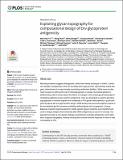| dc.contributor.author | Zhao, Peng | |
| dc.contributor.author | Draghi, Monia | |
| dc.contributor.author | Arevalo, Claudia | |
| dc.contributor.author | Karsten, Christina B. | |
| dc.contributor.author | Suscovich, Todd J. | |
| dc.contributor.author | Gunn, Bronwyn | |
| dc.contributor.author | Streeck, Hendrik | |
| dc.contributor.author | Brass, Abraham L. | |
| dc.contributor.author | Tiemeyer, Michael | |
| dc.contributor.author | Seaman, Michael | |
| dc.contributor.author | Mascola, John R. | |
| dc.contributor.author | Wells, Lance | |
| dc.contributor.author | Alter, Galit | |
| dc.contributor.author | Yu, Wen-Han | |
| dc.contributor.author | Lauffenburger, Douglas A | |
| dc.date.accessioned | 2018-09-11T14:02:57Z | |
| dc.date.available | 2018-09-11T14:02:57Z | |
| dc.date.issued | 2018-04 | |
| dc.date.submitted | 2017-05 | |
| dc.identifier.issn | 1553-7358 | |
| dc.identifier.issn | 1553-734X | |
| dc.identifier.uri | http://hdl.handle.net/1721.1/117701 | |
| dc.description.abstract | Mounting evidence suggests that glycans, rather than merely serving as a “shield”, contribute critically to antigenicity of the HIV envelope (Env) glycoprotein, representing critical antigenic determinants for many broadly neutralizing antibodies (bNAbs). While many studies have focused on defining the role of individual glycans or groups of proximal glycans in bNAb binding, little is known about the effects of changes in the overall glycan landscape in modulating antibody access and Env antigenicity. Here we developed a systems glycobiology approach to reverse engineer the complexity of HIV glycan heterogeneity to guide antigenicity-based de novo glycoprotein design. bNAb binding was assessed against a panel of 94 recombinant gp120 monomers exhibiting defined glycan site occupancies. Using a Bayesian machine learning algorithm, bNAb-specific glycan footprints were identified and used to design antigens that selectively alter bNAb antigenicity as a proof-of concept. Our approach provides a new design strategy to predictively modulate antigenicity via the alteration of glycan topography, thereby focusing the humoral immune response on sites of viral vulnerability for HIV. | en_US |
| dc.publisher | Public Library of Science | en_US |
| dc.relation.isversionof | http://dx.doi.org/10.1371/journal.pcbi.1006093 | en_US |
| dc.rights | Creative Commons Attribution 4.0 International License | en_US |
| dc.rights.uri | http://creativecommons.org/licenses/by/4.0/ | en_US |
| dc.source | PLoS | en_US |
| dc.title | Exploiting glycan topography for computational design of Env glycoprotein antigenicity | en_US |
| dc.type | Article | en_US |
| dc.identifier.citation | Yu, Wen-Han, Peng Zhao, Monia Draghi, Claudia Arevalo, Christina B. Karsten, Todd J. Suscovich, Bronwyn Gunn, et al. “Exploiting Glycan Topography for Computational Design of Env Glycoprotein Antigenicity.” Edited by Greg Tucker-Kellogg. PLOS Computational Biology 14, 4 (April 2018): e1006093 © 2018 Public Library of Science (PLoS) | en_US |
| dc.contributor.department | Massachusetts Institute of Technology. Department of Biological Engineering | en_US |
| dc.contributor.mitauthor | Yu, Wen-Han | |
| dc.contributor.mitauthor | Lauffenburger, Douglas A | |
| dc.relation.journal | PLOS Computational Biology | en_US |
| dc.eprint.version | Final published version | en_US |
| dc.type.uri | http://purl.org/eprint/type/JournalArticle | en_US |
| eprint.status | http://purl.org/eprint/status/PeerReviewed | en_US |
| dc.date.updated | 2018-09-07T18:31:36Z | |
| dspace.orderedauthors | Yu, Wen-Han; Zhao, Peng; Draghi, Monia; Arevalo, Claudia; Karsten, Christina B.; Suscovich, Todd J.; Gunn, Bronwyn; Streeck, Hendrik; Brass, Abraham L.; Tiemeyer, Michael; Seaman, Michael; Mascola, John R.; Wells, Lance; Lauffenburger, Douglas A.; Alter, Galit | en_US |
| dspace.embargo.terms | N | en_US |
| dc.identifier.orcid | https://orcid.org/0000-0002-0050-989X | |
| mit.license | PUBLISHER_CC | en_US |
